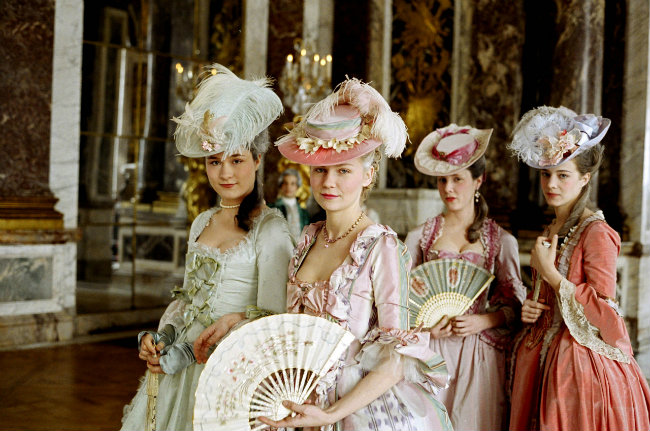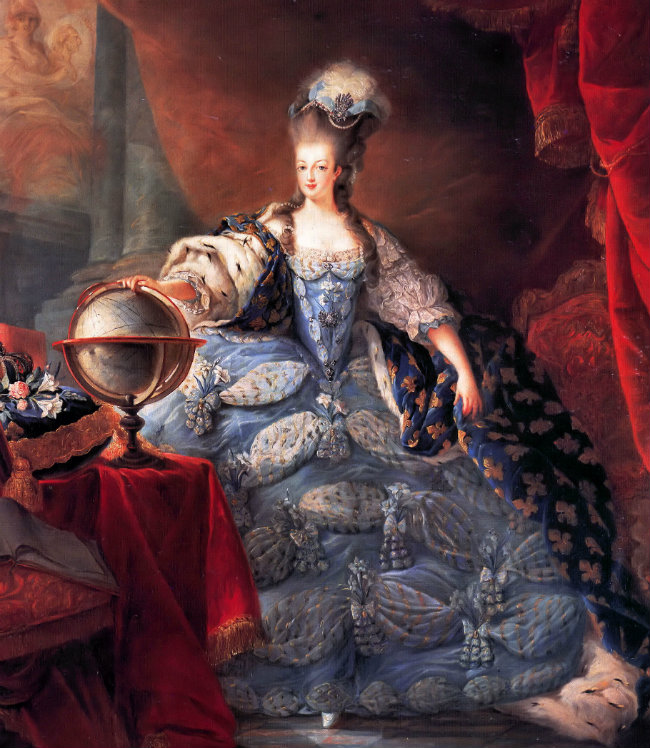Another piece in our fashion history puzzle, right after
Baroque, in the beginning of the 18th century, a more complicated style and one of my personal favourites, Rococo.
Otra pieza en nuestro rompecabezas en la historia de la moda. Justo después del Barroco, en el comienzo del siglo 18, un estilo más complicado y uno de mis favoritos personales: El Rococó
We can place Rococo around 1730, it was a more evolved and playful style.
Also called, late Baroque, the Rococo took place in France as a response against the structures of Baroque.
We need to explain first of all the social situation in France because everything that happened during this period, ended in one of the most important revolutions so far. At that time, the Enlightenment was the most important cultural movement, trying to reform society using reason, against the abuses of power by the church and the state and science as a new form of advanced knowledge. The absolutist monarchies were spending the people’s money in endless parties, balls and feasts, France decided to show their power by supporting the United States independence revolution against Britain and the rest of the population was miserable, hungry and tired of the entire situation. Political movements were forming and gaining more followers by the minutes with the only intention of being free and without any crowns above their heads.
But the monarchy wasn’t thinking about that, on the contrary, they were celebrating their power and divine glory, because in their eyes, they were chosen by God.
The new style opted for asymmetrical forms and pastel colours, gold and lots of curves and opulence, details everywhere, making every single thing a work of art. The empires were growing fast and had no danger (in their minds) of falling apart, therefore the high classes gained influence and power, which was of course reflected in the way they dressed. Basically, the rococo was a way to celebrate the figure of the monarchy, the power and glory of the King itself.
Later on the entire court and nobility carried the trend in their own houses and ways of dressing.
The silhouette in women’s garments changed as well, waists were compressed very tightly in corsets, wide panniers were used under dresses paired with very elaborated hairstyles with huge hats adorned with ribbons and feathers, small figurines and even powdered with flour to keep the shape (which was extremely bad since the country was starving because the price of the bread was as high as the queen’s hair). The bigger the better, so wigs and extensions were needed. Fashion designers and magazines started to get more importance in this period, we can actually see the first “trend setters” such as Madame du Pompadour (picture above), the Duchess of Devonshire (in england) and of course, Marie Antoinette. The gowns were made out of very heavy fabrics and materials. One of the popular styles was the one known as –robe à la française – or sack-back gown usually they were open at the front showing and underskirt of the same fabric or a contrasting one, it had fabric in the back kind of as a cape that leaded into a train, elbow-length sleeves ended with frills and ruffles and the necklines were open usually squared and trimmed with lace ruffles. The other style known as robe à l’anglaise featured pleats in the back that would fade into the skirt. Both man and women wore what we know know as “Louis shoes”, they had high curved heels made out of leather or fabric with some kind of decoration such as a buckle, a broach or something of that sort.
Men’s style didn’t change as much, they kept wearing waist coats and breeches (a knee high kind of legging) the only thing that did change was the attention to cut and fabrics, making everything more lux and detailed. As for the working and lower classes, nothing changed either, they still wore rags. They hated these open declarations of wealth and power, instead of knee high breeches, they had ankle-lengths trousers so by the time the revolution came, wearing something similar to a high class outfit was actually dangerous.
The revolution came and if you were part of it, then you would have a rosette proudly in red white and blue pinned somewhere, but if not, the revolutionaries would accuse you of being part of the aristocracy and actually kill you. That’s something you can say whenever you hear that fashion wasn’t important in history.
It was indeed a matter of life or death.
In 1789 the Bastille was stormed, during riots and that’s how the revolution started ending in blood baths, rolling heads and a new order in the country.
Everything was changing and fashion was not left aside.
Podemos ubicar el Rococó alrededor de 1730,este era un estilo más juguetón y evolucionado, también llamado Barroco tardío. El Rococo tuvo lugar en Francia como respuesta al estilo estructurado del Barroco.
Primero necesitamos explicar la situación social de Francia, porque todo lo que pasó durante este periodo culminó en una de las revoluciones más trascendentales hasta ahora. En ese momento, el iluminismo era el movimiento cultural más importante, tratando de reformar la sociedad usando la razón, en contra de los abusos de poder por parte del Estado y la Iglesia, y teniendo a la ciencia como una nueva forma de conocimiento avanzado. Las monarquías absolutistas gastaban el dinero de su pueblo en fiestas sin fin, bailes y festines. Francia decidió mostrar su poderío apoyando la independencia en Estados unidos mientras el resto del país vivía en la miseria, hambriento y estaba cansado de esta situación. Movimientos políticos se formaban y ganaban más seguidores a cada minuto, con la única intención de ser libres sin ninguna corona sobre sus cabezas.
Pero la monarquía no estaba pensando en eso, por el contrario, celebraban su poder y gloria divina porque en sus ojos, “habían sido elegidos por Dios”.
Este nuevo estilo opto por formas asimétricas colores pasteles, oro , muchas curvas y opulencia, detalles por todas partes, convirtiendo absolutamente todo en una obra de arte.
Los imperios crecían rápido y no peligraban (en sus mentes) , por lo tanto las clases altas ganaron influencia y poder, lo que claramente fue reflejado en la manera de vestir. Básicamente el Rococó fue una forma de celebrar la figura de la monarquía. El poder y la gloria del mismísimo Rey.
Luego toda la corte y la nobleza siguió la tendencia hacia sus hogares y formas de vestir.
La silueta de las mujeres cambió también, las cinturas estaban comprimidas por corsets , unas enaguas anchas eran usadas debajo de los vestidos acompañados por peinados muy elaborados usados con sombreros de plumas y cintas, figurines pequeños y hasta empolvados con harina!… para mantener la forma (lo que era muy peligroso teniendo en cuenta que el pueblo tenía hambre y el precio del pan era tan alto como el pelo de la reina.) Cuanto más grande mejor, por lo que necesitaban usar pelucas y extensiones. Los diseñadores y las revistas de moda comenzaron a ganar importancia en este período, inclusive podemos encontrar a las primeras “trend setters” como Madame du Pumpadour , la Duquesa de Devonshire en Inglaterra y obviamente, Maria Antonieta. Los trajes estaban hechos de telas y materiales pesados. Uno de los estilos populares era el conocido como- robe à la française – usualmente eran abiertos adelante dejando ver una falda de la misma tela o de otra contrastante, tenían mucha tela en la parte de atrás como una especie de capa que luego terminaba en una cola, mangas al codo con volados y por lo general escotes abiertos y cuadrados con bordes de encajes y volados. El otro estilo popular era el robe à l’anglaise que en lugar de la tela colgando tenía unos recortes en la espalda que luego se incorporaban a la falda.
Tanto los hombres como las mujeres usaban los zapatos que hoy conocemos como -zapatos luis xvi- que tenían un taco curvo y alto hechos de cuero o tela con algún adorno tipo hebilla, broche o algo por el estilo.
El estilo de los hombres no cambió mucho, siguieron usando sacos y breeches (una especie de calza a la rodilla) lo único que sí cambió fue la atención a los cortes (que eran mas entallados) y a las telas, haciendo todo más lujoso y detallado. En cuanto a la clase baja y trabajadora, siguieron usando harapos Ellos odiaban estas demostraciones abiertas de poder y riqueza asi que en lugar de usar los breeches usaban unos pantalones por los tobillos. Para cuando la revolución llegó, usar algo similar a los atuendos de las clases altas era realmente peligroso.
La revolución vino y si eras parte de ella, tendrías una escarapela en rojo, blanco y azul en alguna parte de tu pecho puesta muy orgullosamente, pero si no, los revolucionarios te acusarían de ser parte de la aristocracia y te mataban. Eso es algo que podes decir cuando escuches que la moda no fue importante en la historia. Era realmente un caso de vida o muerte.
En 1789 la Bastilla fue tomada durante saqueos y así fue como la revolución empezó, terminando en baños de sangre, cabezas rodantes y un nuevo orden en el país.
Todo estaba cambiando y la moda no fue dejada de lado.








muy interesante!
Odio cuando dicen que Maria Antonieta es victoriano
AY POR FAVOR SI.
Cool q escribas sobre esto!
Me emociona mucho que escribas sobre esto, a veces me siento una loca escribiendo los posts que hago, pero no… no soy la única (ni somos las únicas) apasionadas en esto, te felicito ♥
ah~ Maria antonieta no es victoriano? y ahora que hago con mi vestido? pff XD super genial Less, me encanto ♥